As an Amazon Associate I earn from qualifying purchases.

In Charleston, South Carolina, rice was once king. And this Lowcountry perloo was once one of that region’s crowning dishes.
Perloo. Such a strange name, and spelling. It gets even stranger when you see it spelled purloo or perlo. But if you say it, and you’ve been exposed to the cooking of certain parts of the Middle East, India or East Africa, you’ll recognize that this is a version of pilau.
And if you eat it, you will taste echoes of its more famous cousin, Louisiana jambalaya.
Perloo’s origins lie in Africa. West Africa, to be exact. The concept of a one-pot, rice-and-whatever dish exists wherever rice is grown, and in Senegal there is a dish known as jollof rice, with its own variations throughout that part of Africa. Two centuries ago, Charleston was the entry point for roughly 40 percent of all African slaves to this country, and the city’s cuisine reflects those African roots.
Even the rice is African, Oryza glaberrima, which is a different species than the Asian rice we all buy today. And while African rice hasn’t been grown commercially in the Lowcountry since the 192os, it’s recently been revived as Carolina Gold rice, which is a hybrid between the old African rice and Asian varieties. (You can buy buy Carolina gold rice online.)
Many varieties of perloo exist. I’ve seen them loaded with pig parts, with chicken, rabbit, or game. But mostly perloo is about seafood, and mostly that seafood means shrimp, crab and oysters.
Mine just has shrimp, but you can add the other seafood if you’d like.
What shrimp? Well, American shrimp, of course. I strongly urge you to seek out real American, usually Gulf, shrimp. Our shrimp industry is as sustainable as any in the world, it doesn’t destroy the environment the way Southeast Asian shrimp farming does, and, importantly, supports American jobs. Any size shrimp will do.
Me? I catch my own. My friend Joe Baya of the magazine Great Days Outdoors has a recreational shrimp net we haul around when I visit him on Dauphin Island, south of Mobile, Alabama. Dauphin Island is just down from Bayou la Batre, of “Forrest Gump” fame. So the shrimp in the picture are Gulf shrimp, not South Carolina shrimp.
Some sort of smoked pork is vital to a good perloo. Bacon is what I use, but salty country ham or salt pork will also work. Jowl bacon is ideal. And yes, I’ve seen sausage in perloo, too, but to me that tips it a bit too close to jambalaya.
When you make this, it makes enough for a crowd. So if you’re not a crowd, reheat your perloo in a microwave for 30 seconds or so, or do what I do and reheat it on the stovetop in a covered, non-stick pan over very low heat for about 20 minutes.
Lowcountry Perloo
Ingredients
- 2 pounds shrimp, with shells (and heads if possible)
- 2 bay leaves
- 1 onion, chopped
- 1 large carrot, chopped
- 2 celery stalks, chopped
- 1/4 pound thick-cut bacon
- 2 cups chopped white or yellow onion
- 2 cups chopped celery stalks
- 1 yellow bell pepper, diced
- 2 large garlic cloves, minced
- 2 1/2 cups rice
- 1/2 cup white wine
- 1 14.5 ounce can fire-roasted tomatoes
- 1 datil, fish or habanero chile, minced (optional)
- 1/3 cup chopped parsley
- Black pepper to taste
Instructions
- Peel all the shrimp and put the shells, and heads if you have them, into a pot with the bay leaves, onion, celery and carrot. Cover with 7 cups of water and bring to a simmer. Simmer gently for 30 minutes while you chop everything else for the perloo.
- As the stock is simmering, slowly fry the bacon in a large, heavy pot. When it is crispy, remove the bacon (eat a slice) and chop roughly. Set the bacon aside.
- Saute the 2 cups chopped onion, 2 cups chopped celery and the diced yellow bell pepper in the bacon fat until soft but not browned. Add the garlic and rice and cook, stirring often for 3 minutes, until the rice turns translucent.
- Add the white wine, tomatoes and chile pepper to the pot and stir well.
- Set up a fine-meshed strainer with a paper towel in it. Ladle two or three ladles of the shrimp stock through this strainer into the rice pot. Stir well. Cook, stirring often, until the liquid is absorbed. Repeat this process until the rice is tender.
- Add one more ladle of shrimp stock to the pot, along with the shrimp and the parsley. Mix to combine, cover the pot and turn the heat to its lowest setting. Cover for 5 minutes to let the shrimp cook, then mix in the bacon and black pepper and serve.
Nutrition
Nutrition information is automatically calculated, so should only be used as an approximation.

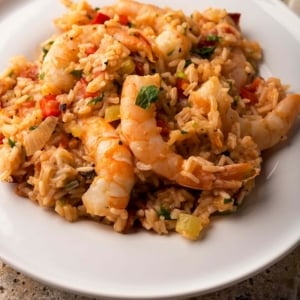
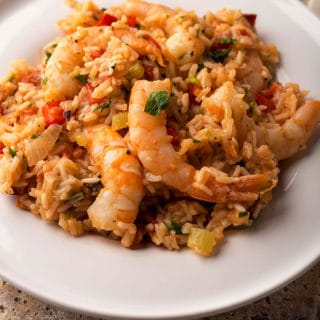
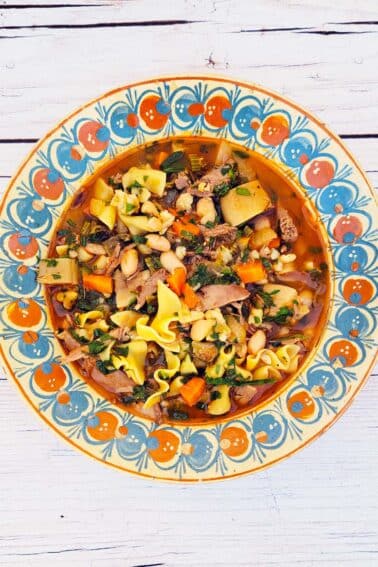
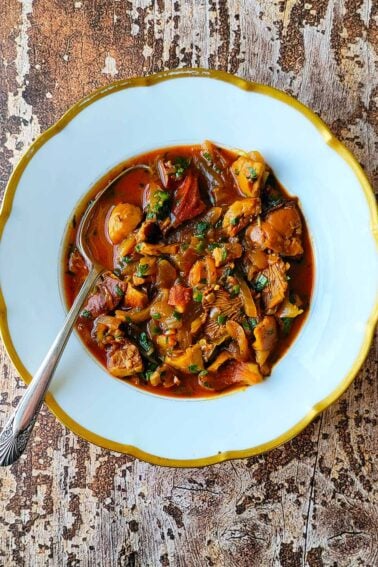

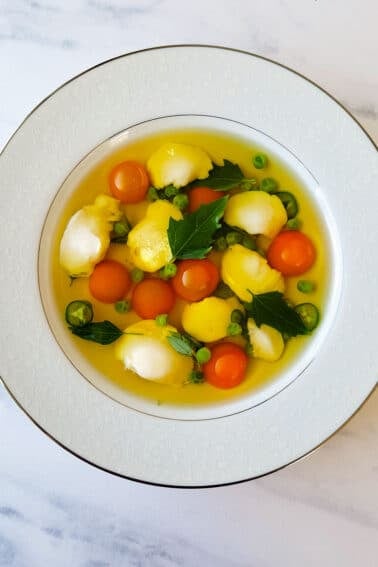
From Germany, I came across your website. Completely new to this region of American cooking (mostly familiar with PA.NJ.), I made the Shrimp Perloo according to your recipe with the ingredients I had at hand here in Germany. It was SUPERB!!! My husband loved it although he often is very reluctant to try new recipes I make. Delicious. Thanks from Germany
I’m surprised you being from the low country you didn’t say to use Carolina gold Rice! It is spectacular in any dish!
Sorry, I’m a little bit confused with this. Be because th0ere was no specifics as to how to cook the Rice.
What kind of rice?are going to put a lid on it and simmer it? ? It’s a lot of liquid for the amount of rice: to meet it sounded like mush. anybody out there who knows the answer i’d love to hear It.
Michael: Regular long-grain rice. No lid. And you end up having a bit more stock than you need. It’s definitely not mush, because you are adding water as you cook, so you taste the rice along the way, and when it is done, you don’t add more liquid.
Absolute best shrimp dish I’ve ever eaten. I’ve made this so many times I can’t count. I highly recommend getting some Carolina Gold rice for this recipe alone!
The shrimp in the picture are from where “Forest Gump” was netting in the movie, but they filmed the shrimping boat scenes in South Carolina!
Jeepster: Ha! I had no idea.
Your purloo recipe is superior in my opinion because you emphasize the use of the Carolina Gold rice (not a big rice fan) which is far superior (I love this rice).
Also using the shrimp shells and heads to make the stock vs chi ken stock.
Great recipe thank you.
I will follow you from now on, just on the sheer fact that you said eat a piece of bacon while it’s there!
Should the stock be covered or uncovered? At what temperature should the simmering rice cook? What is a good substitute for Carolina Gold? I am in Canada
Thanks!
Katherine: The stock is uncovered. I simmer rice on medium-low. A good substitute for Carolina gold is any long-grain rice you like.
This was very good. I used 2 cups of Carolina Gold Rice and added salt and pepper throughout the recipe as I added ingredients. Also added a little crushed red pepper towards the end (I omitted the habanero). Definite crowd pleaser. I do think this would have fed closer to 7-8 adults than 6, and I used 2 c rice vs 2.5 in the recipe.
Excellent dish, but needs salt, probably in the broth. I am picky and always devein my shrimp, top vein primarily, because I rarely see the lower vein in cooked shrimp. However, if the shrimp are small, you can probably skip it altogether. I have long wanted to try Carolina Gold rice, and I finally found it at Soda City in Columbia last weekend. This dish is a lot like the risotto my husband frequently makes. I would say you should opt for a whole habanero, and possibly a little red pepper flakes. The kick helps, especially with a recipe that is light on seasoning.
What are your thoughts about de-veining shrimp? I go either way, but it depends on how the shrimp are being used, LC boil vs. saute.
Stephen: I examine the shrimp and if they have dark ick in the poop line, I devein them. If not, I leave it be.
Ohhh, we Armenians can’t resist a good rice dish. This changes things up. I’m going to put it on the table this weekend!
Would you believe we have experienced datil chilis in a terrific sauce that we found in the St. Augustine area. The brand was dr. datil and he also made sauces (I’m not affiliated). We love anything spicy and I agree Gulf shrimp is fantastic. We do visit the Atlantic side quite a bit and enjoy their shrimp but there is something about the Gulf ones that we prefer. We’re looking forward to making this recipe.
The best (and most realistic) instruction in print: “cook bacon, eat a piece, then cut up the rest” I love it!
This is a family staple for generations. I make it simply by sautéing the bacon with onions, celery, peppers and seasoning in a large pot, pour in a quart of pot liquor, bring to a boil, add your game or seafood for just a minute or so and finally add 2 cups of rice and simmer until rice is just right, stirring occasionally. One pot, low mess and feed the masses!
Hank, another source of Carolina Gold rice is https://ansonmills.com/